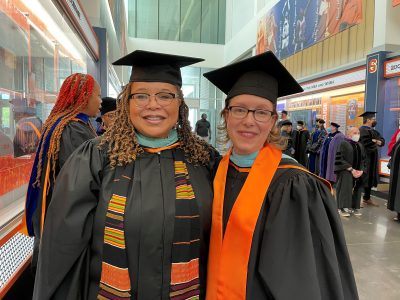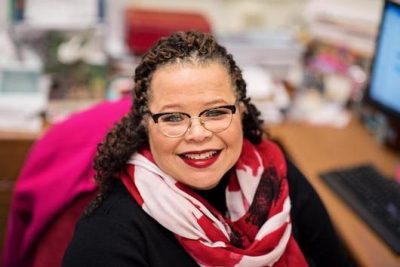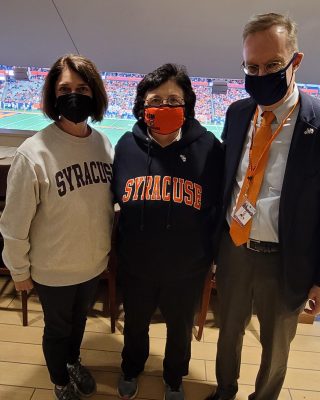Two award-winning school leaders and SOE alumnae reflect on educational challenges and how they are meeting them with rigor, care, and joy

“Teachers are stretched now more than ever,” explained Professor George Theoharis in a June 4, 2022, AP news story in the wake of the Uvalde, TX, school shooting tragedy. “We’re sort of left in this moment where we expect teachers and schools to solve all our problems and do it quickly.”
The list of external pressures on schools is long and familiar, including, in the past couple of years, the coronavirus pandemic, ongoing gun violence, and political push-back on efforts to foster diversity, equity, and inclusion among learning communities. How are frontline school leaders addressing this moment on behalf of their teachers, staff, and students?
Donna DeSiato G’04, Superintendent of East Syracuse-Minoa Central School District, and Eva Williams G’00, Principal of Van Duyn Elementary School in the Syracuse City School District, sat down to discuss how they are tackling challenges their schools—one suburban and one urban—must meet, now and in the future.
Both School of Education alumna have been recognized by New York State for their exemplary leadership. In April 2021, Williams was named Elementary Principal of the Year, and in September, DeSiato was named Superintendent of the Year.
Learn more about our fully online C.A.S. in Educational Leadership, and flexible hybrid Ed.D. in Educational Leadership, both designed for working professionals and educators to complete on their own time—and other graduate programs in education, counseling, instructional design, and more.
Q: What strategies have you implemented to support teachers in these challenging times?
Eva Williams: It’s constant affirmation of the work we do together and affirming what they’re doing in their classrooms. At Van Duyn, we shout out the good work of staff when we see it.
Also, it’s being understanding. We leave the door of communication open so people feel comfortable talking with me or the vice principal. Having relationships that are trusting and loving should be number one. When you know what somebody is going through and they ask you for an accommodation, you can do it.
“Joy is a big piece of learning. You have to love what you’re doing, see yourself in it, and understand how it’s going to take you further.”
—Eva Williams G’00
We also encourage #FunInLearning—that’s the Van Duyn social hashtag! It’s not just Teacher Appreciation Week; we use other times of the year for spirit weeks and celebrations. And I know, people might say, “Oh, they think a box of doughnuts is gonna make this job easier.” But the truth is, I don’t have a magic wand. The ability to increase teacher morale stems really from having that relationship with your staff and meeting their needs.
There’s no fairy dust to sprinkle and make everybody happy. It’s about seeing each person for who they are and what they need.
Donna DeSiato: There’s no playbook for our immediate world, in a pandemic. We’ve woven in various aspects of social emotional supports and ways to either energize or lift up the spirits of our learning community. For instance, in the fall 2020, we had “Thankful Thursdays.” Every Thursday, our media and communications, youth development, and leadership teams created an internal video, such as parents sharing heartfelt messages and thanking teachers for what they are doing.
We also make resources available, an ongoing process. We’ve invited a local professional who’s doing very targeted group sessions on social emotional wellness, and when we open in the fall 2022, on our very first day, we will have a very focused agenda on wellness. We best serve our students if we are also taking care of ourselves.
Q: Given widespread reports of a national teacher shortage, how are you approaching recruitment?
EW: When we recruit, we work with Syracuse University and other local institutions. We take in students to see if a candidate is a really good teacher. If I get an opening, then this student is the one that I’m going to hire. In the past, we’ve been able to do that, hire one or two student teachers. So our method of always having a group of solid candidates is to have student teachers in our buildings and to cultivate them within our culture. Then if there are openings, you’ve got a solid person.

DD: Nationally, there’s certainly areas in which there are not as many teachers coming into the profession and the pools are not as deep as they once were. Having said that, we also benefit from the fact that our work is recognized in this region as focusing on what matters. We attract people to our district, and that’s intentional. We designed the district so that not only students want to come but also professionals, teachers, administrators, teaching assistants, clerical, custodians, and bus drivers. That’s what we need to do—create a place where people know that they’re valued and that their work is focused on what really matters: educating the youth of today.
We’re constantly looking at strategies for recruitment and retention. We hold employee recruitment fairs, for example—our transportation center had one in summer 2020 to attract bus drivers. They did a cookout with hotdogs on a Saturday morning. You could stop by, grab a hotdog, and sign up to be a bus driver. Those strategies get people’s attention.
Q: How is your district incorporating teaching strategies—especially technological ones—developed during the pandemic?
EW: The use of technology prior to the pandemic was really instrumental in supporting what happened during. I don’t think it’s the other way around. Students were able to go in and know the digital content that we wanted them to work on. The digital platforms—like Seesaw—already existed. With our students, that easily transferred once they went home.
“We want to respect diversity and ensure we are recognizing the importance of being valued and belonging.”
—Donna DeSiato G’04
Those pieces are going to stay because they were useful before, during, and now. For example, if a parent is at work or can’t leave home, now we have a way to engage them using the computer. Before folks would come into the building, which we are starting to do again, but now we have two different platforms to access families.
DD: In-person learning, ultimately, is the gold standard because you’re also addressing students’ social emotional development.
We were a one-to-one school five years before the pandemic hit, meaning one device—Chromebook Google Classroom—to each student. Our students already were well-versed in technology. What the pandemic did was intensify the need to use it.
Students are born into a digital world. They understand that technology will be an ongoing part of their life, and we need to ensure we’re equipping them to utilize the technologies that are out there in ways that are going to help them not only learn but also apply their learning to solving problems.
This year, the students who remained entirely virtual had the most challenging time readjusting to in-person. So we know that we need to spend time in the next school year to really reset all learning expectations. This will help our students understand what the appropriate protocols and boundaries are and be better adjusted to the learning environment than they have been.
Q: But does hybrid learning mean an end to Syracuse snow days?!
EW: We thought about going virtual on snow days, but it wasn’t right. Families were not happy. Everybody wanted a snow day, whether they were home or not. Right now, we don’t have a district whereby every family has a device or that every family has internet access. We’re not living in that community, yet. So we are still having snow days. We had so many this year, we lost our additional Memorial Day holiday!
DD: We make those decisions according to the storm, what conditions are, and whether we’re going to be out for one or multiple days. Our secondary students typically carry their devices back and forth, but elementary students don’t, for good reasons. There’s a lot that goes into connecting all those devices, having them at the needed locations, and then being able to send them home and bring them back. So we are very mindful of decisions we make and what kind of stressors we place on children and families, perhaps unnecessarily.
“You only get to be a child for so many years. We should never lose sight of what makes us smile and what makes us happy. If we capture that, at a young age, we will remain youthful all of our lives.”
—Donna DeSiato G’04
And there are times when we just need to let go and have fun for a moment. I happen to be a superintendent who—when I have time and snow is forecast in advance—will sing a song or do a verse and rhyme to our students to announce a snow day. You only get to be a child for so many years. We should never lose sight of what makes us smile and what makes us happy. If we capture that, at a young age, we will remain youthful all of our lives. So I want children to know the joy that they can have in learning, but I also want them to know the joy they can have in living and loving life, and in loving being with their family. I think it’s all part of our growth and development.
Q: Looking ahead, what do you see as your top challenges?

EW: Getting back to rigor and high expectations for our students. I think we, as a nation, have not brought our solid work ethic back to the table. We need to up our academic rigor.
In the coming years, the challenge is deciding what do children actually need to know? Consider the cancellation of the June 2022 New York Regents exam in US History and Government, because it was thought something might be trauma-provoking to students. What are we teaching that would have caused a child to have some sort of response to a test? How far do we have to go with assessments to know that we’re on the right track and that we’re giving children what they need for 21st century learning? How are we going to infuse cultural responsiveness and engagement with diversity for all?
DD: I think without question, safety and security will be paramount, in the health arena and in regard to recent national events. The continued challenges of shifting to a truly 21st century learning environment will mean that learning becomes the focus and time becomes the variable, and measures for learning will become less standardized and more individualized, diagnostic, and informative.
Mental health challenges are going to be significant. We have to address this in a way that integrates support systems into our school systems, creating accessibility.
Q: How will your district continue to support educational equity for all students?
EW: Equity is what we do here every day. We look through that lens. We ask, will students receive this? Will it meet their needs? Will it push them further? Can our students and our staff see themselves in everything we do? Will they find joy in what they’re learning?
“How far do we have to go with assessments to know that we’re on the right track and that we’re giving children what they need for 21st century learning? How are we going to infuse cultural responsiveness and engagement with diversity for all?”
—Eva Williams G’00
Joy is a big piece of learning. You have to love what you’re doing, see yourself in it, and understand how it’s going to take you further.

DD: Our approach is that it is everyone’s responsibility to look at everything we do through a multi-perspective lens of diversity, equity, and inclusion. We want to respect diversity and ensure we are recognizing the importance of being valued and belonging.
It’s not a program. It’s not a person in an office that somehow sends out messages or plans activities. Diversity and equity are integrated into our curriculum. It’s the responsibility of all of us.
Q: What are your final thoughts as you reflect on your educational challenges, and successes?
EW: I want to encourage people of all ages to seek a career in education. I think we are at a time in our society where we need the best people with the biggest hearts and creative minds to come and celebrate teaching and to open up doors for learning that we may not have thought of in the past. So, I really encourage this field of work because we are going to be the game changers, the world changers. If we want a better, brighter world, then we need better brighter folks to engage in education.
I’ll also go back to being joyful and seeing yourself in everything you do. When we’re teaching, and students can see the contributions of people who look like them—when you can see yourself in them—then you know this school where I belong. It’s where I fit, and it belongs to me. I will be a better person for learning in that space. And that’s so important.
DD: We must focus on creating a welcoming, safe, secure, and healthy environment. Each year, we look at various aspects of all of our practices to compare them with what the research is telling us. Most importantly, we listen to what our parents tell us in surveys and through feedback and to what students, community organizations, and business partners say we need to do, so everyone feels welcomed by being listened to and by understanding there’s a place here to have a voice.
We must work at that so that we have harmony in those voices, rather than conflict or tension. This is a part of both our strategic and school improvement plans. Our schools are really doing a great job of focusing on creating this welcoming environment.
Editor’s Note: A condenses version of this interview was published in the 2022 issue of Education Exchange Magazine.
